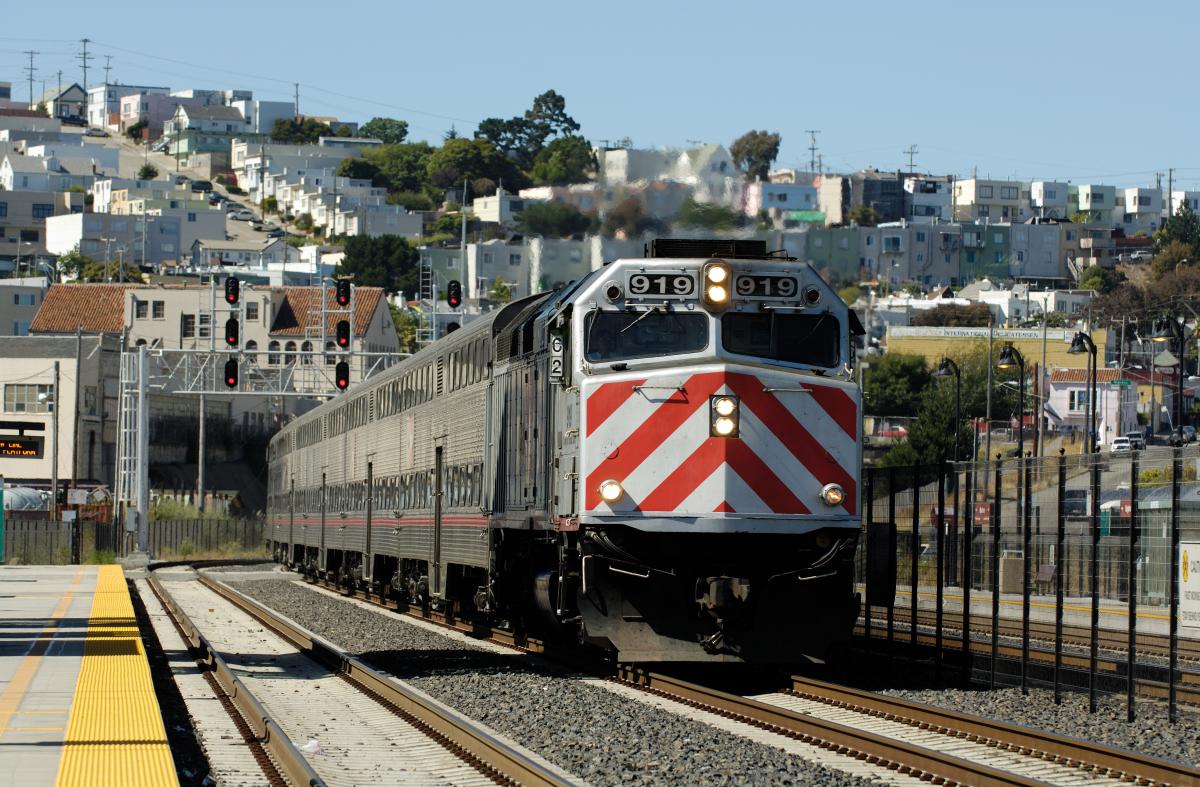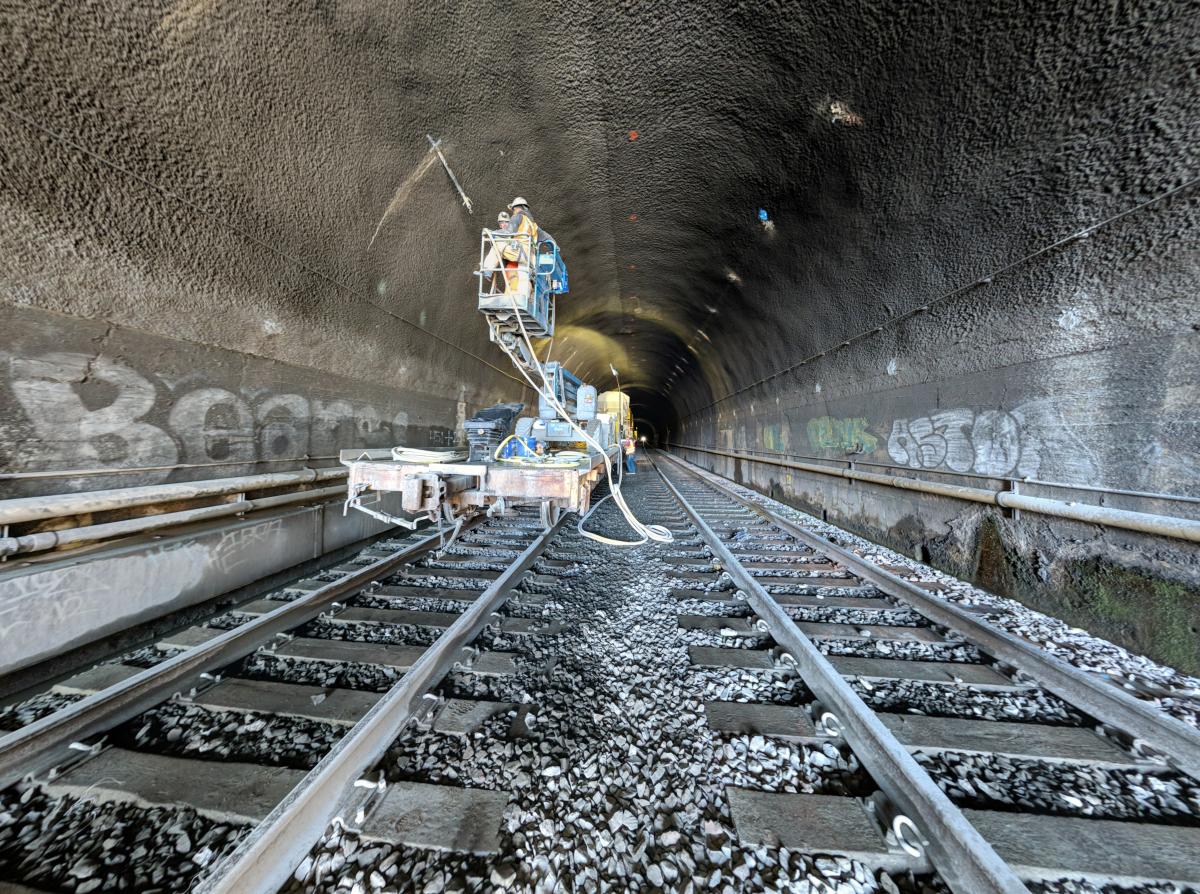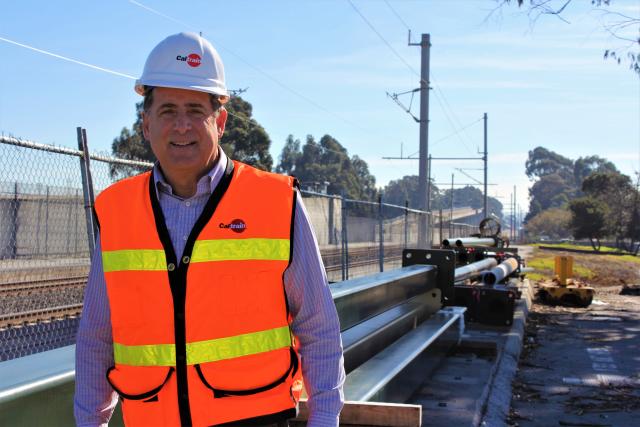By Alex Eisenhart | @AlexOnTransit | January 30, 2019
Nearly a year into his tenure as Chief Officer of the Caltrain Modernization Program (CalMod), I sat down with John Funghi to dive into the work his team is doing to electrify Caltrain, the history of the railroad and his personal journey to the world of public transportation. [wpvideo M3vszFsO] EISENHART: Let’s start by talking about you, John. Where are you from originally? FUNGHI: Sure – I was born in the Mission District of San Francisco in 1960. My parents emigrated from Italy, hence the last name. It translates to “mushroom” in Italian. We lived in a basement apartment next door to my grandparents. Mom, a credentialed school teacher in Italy, found work as a seamstress at the San Francisco Levi’s factory. My father initially found work in a Tannery factory. My family only spoke Italian, so by the time I started elementary school I didn’t know a word of English. It became my second language. EISENHART: So what brought you into public transportation? FUNGHI: I’ve always been interested in the building profession. In high school I worked as a laborer for a local construction company. When I graduated college I was fortunate enough to be hired by Morrison-Knudsen. One of the largest construction firms in the country at the time. They built the Hoover Dam! From there I worked on large infrastructure projects in Alaska, Hawaii and California. It increased my passion for building. I found it satisfying to develop building concepts and watch them come to fruition. What brought me into public transportation was my family. I got married, had kids and realized that relocating from job to job was going to be hard on all of us. So I sought work that would keep me local to our home on the Peninsula. I accepted a position with MUNI in 1999 as the Program Manager in charge of major MUNI operation facilities. This was back when the agency was receiving the Breda light rail vehicles, which have been operating on Muni for the last 20 years and are now in the process of being retired. But at the time, they needed infrastructure improvements to support those new vehicles, like new paint & body shops, wheel truing machines, axle presses, and cranes in order to maintain their new fleet of vehicles. It’s a very similar transformation to what we’re experiencing today at Caltrain as we get ready for the anticipated arrival of our new electric trains. From there, I became the Program Director of the Central Subway Project. It’s the first underground subway system to be constructed in San Francisco since the late 1960’s. I enjoyed my time at MUNI and the lifelong friendships that I continue to enjoy. EISENHART: How’s your first year at Caltrain been? Talk more about that shift from light rail to commuter rail. FUNGHI: When the CalMod program came about and the search began for a Chief Officer, I knew that it was an amazing opportunity. I am honored to have been selected and to have served in this role over the past year. It has widened my horizons as I’ve transitioned from building underground light rail systems to above ground commuter rail. I am pleased to work alongside a staff of smart, dedicated professionals here at Caltrain. Some of these folks have been working on CalMod for over a decade and the credit for its success goes to them for getting this program to where it is today. The biggest challenge for me was learning the acronyms. Government is already a world of obscure acronyms, so when you combine that with geeky new engineering jargon on top of that, it can be a lot keep up with. Happy to say I think I have it down now.

Another challenge is that, while a commuter rail is linear, it’s much more impactful to the communities that the CalMod program will serve. This new electrified line is going to make a major difference to all of the cities along the Peninsula. We currently have a well-worn, well used diesel system with locomotives that are beyond their useful life. The system we have is good and well maintained, but it’s old and needs to be retired. I know that once we go to more European style electric trains, it’s going to be extremely popular and will continue to benefit the communities we serve. EISENHART: Any interesting changes you’ve observed along the Peninsula? Fun facts about the railroad? FUNGHI: The railroad has been here since the time of Abraham Lincoln. It’s had a profound impact on the development of cities along the Peninsula as a catalyst for economic and housing development throughout the region. The transformation that I’ve observed has really been in the South Bay, which used to be orchards and is now the heart of the tech industry. I attribute some of that to Caltrain and the ability to get people to and from work. Historically, the old commute model would bring commuters into San Francisco in the morning and back home to the Peninsula at the end of the day. That is in stark contrast to the model we experience today, which has commuters moving in both directions, at all hours in the day. Given the constrained land use on the Peninsula, I think growth throughout the County has been fairly smart. We don’t have the ability to sprawl like you see in the East and South Bay. Here what you tend to have is controlled development around public transportation, which is evident if you travel down El Camino Real. Many of our riders live right at our front door. That puts a lot of pressure on public transportation, and I feel proud to support Caltrain’s effort to modernize and build capacity for the projected boom in ridership as the transportation and economic landscape continues to change.

EISENHART: What changes can riders expect once the new electric vehicles enter service? FUNGHI: Acceleration. Electric propulsion will allow the train to speed up and slow down at a faster rate than our current diesel locomotives. This will effectively save as much as 15 minutes on the commute between San Jose and San Francisco. They’re also a lot quieter. You’ll still hear the train horn as mandated by the Federal Railway Administration, but the sound of the engine itself will be much quieter. EISENHART: Can you talk about the San Francisco tunnel construction happening right now? FUNGHI: There are four tunnels that Caltrain uses to get to/from San Francisco. These hand-constructed, brick arched tunnels are over 100 years old and approximately 36 inches thick. While these tunnels have served us well over the years, we’re limited in the amount of regular maintenance we can perform due to the fact that they only fit the two rail lines going in and out, which are normally used every day of the week. This is why we had to establish the temporary weekend shutdown. We needed to allow for an appropriate window of time to install the necessary electrification infrastructure and perform regular maintenance without impacting the weekday commute.

The construction involves structural strengthening modifications, widening of the tunnel, improving drainage systems and installing the overhead wires that will power the new electric trains. It is anticipated that these tunnels will also be utilized by High Speed Rail in the future and these new electric trains require a more space, so we’re carefully grinding off parts of the upper corners of the tunnels. This process is called notching. We were a little nervous about this part of the project because we weren’t sure how a 100-plus year old tunnel would react to this type of work. We’ve been very pleased with the results. Back then they really knew how to build these tunnels to be extremely stout. EISENHART: Who built these tunnels originally? FUNGHI: I don’t know, but we need to thank them. EISENHART: When is the tunnel work expected to be completed? FUNGHI: We’re expecting to have the work completed in late spring. EISENHART: What’s the next big piece of electrification work? How will it impact riders? FUNGHI: Well, when the tunnels are done we’ll also be done with the weekend shutdowns as it pertains to electrification construction. While that is the most noticeable aspect of our construction, the lion’s share of the work actually happens while everyone is asleep. It starts at 7:30 p.m. and wraps up just before revenue service at 5 a.m. That will continue and we’re very appreciative of the public for their patience. We try to get our noisiest work done earlier in the evening, but fortunately our construction techniques use mostly rotary hydraulic equipment, which minimizes noise.

Overall, we have 3,000-plus foundations to install and poles to erect. To date, we’ve completed about 600 foundations, so we still have a ways to go. Most of that work has taken place between South San Francisco and San Bruno. In a couple months we’ll be shifting our focus to the South Bay, starting in San Jose and making our way up the corridor. In addition to construction milestones, we are eagerly awaiting the arrival of our first electric train set next year in 2020. The car body has been formed and welded. It’s currently undergoing assembly at the Stadler facility in Salt Lake City, Utah. Once it’s been assembled, the train will be taken to a testing facility in Pueblo, CO where it will undergo a rigorous set of what I like to call “engineering gymnastics” to simulate any anomaly that the car might experience while in service to ensure the vehicle’s safety and reliability at all speeds up to 110 miles per hour. EISENHART: Up to 110 miles per hour… but the speed limit on Caltrain’s corridor is 79 miles per hour. Is the maximum speed limit going up? FUNGHI: The short answer – not yet. The new electric trains are mechanically capable of reaching speeds of 110 miles per hour. When we electrify Caltrain and the new vehicles go into revenue service, the maximum speed for all trains on the corridor will still be 79 miles per hour. That being said, in anticipation of blended service along the corridor between Caltrain and High Speed Rail, we plan to eventually make track modifications that will allow for faster speeds along the corridor for all trains, including Caltrain. EISENHART: Once the tunnels are complete, what’s the next big service impact that riders will experience? FUNGHI: Tunnels have definitely been the biggest. From here on out, the impacts related to electrification won’t be any different from what they’re experiencing now, which are temporary service interruptions like single-tracking around work zones. But most of the time when work is happening, it’s outside of regular peak revenue hours. With any construction, there’s no guarantee that an anomaly won’t come up at some point. But I want to assure folks that we’re doing everything humanly possible to minimize commuter impact. EISENHART: What do you say to residents who have expressed concern regarding construction impacts? FUNGHI: With the installation of new electrification infrastructure comes a new way of managing the corridor to ensure safe, reliable operations. Take trees for example. Some residents have expressed concern about our tree-trimming campaign. We understand that change is difficult, but I hope folks understand that what we’re doing is necessary to ensure public safety. In order to operate a safe overhead contact power system, we need to have a minimum safety distance of 10 feet between a tree and an active power line operating at 25,000 volts. It’s hard to build something without creating some temporary discomfort. In an effort to minimize that discomfort, we have incentivized our contractors to respond quickly to public complaints. We provide our contractors with a bonus if they respond within 48 hours. I am happy to say that our contractor has frequently earned that incentive. We owe it to the residents affected by construction to be courteous and attentive in addressing their concerns and I think the incentive can serve as a great model for future construction projects. I also do want to thank the residents who live along the corridor for their patience during these periods of temporary construction as we move closer toward electrification. EISENHART: You’ve got a safety campaign coming up soon – can you talk about that? FUNGHI: Sure – change requires some education. We’ve made significant progress on installing new foundations and poles along the tracks. Next comes the wires. The wires that folks will be seeing between now and 2021 won’t be energized, but it’s a great opportunity to inform the public about these wires and how to avoid hazardous situations. These tips will include things like not leaning a ladder up against the poles and such. There will be also physical barriers around the electrified infrastructure to help avoid such scenarios. EISENHART: Having been in the transportation industry for a long time, how do you think things have changed since you first started out? FUNGHI: I believe the perception of public transportation has improved dramatically in the last few decades. When my parents bought their home in South San Francisco, I lived right next to a SamTrans bus stop. That was my way of getting around. That all changed once I got my driver’s license. Having a car was so important for young people at the time. That doesn’t seem to be as true today. The world has changed and I am seeing that with my own kids. A car is not necessarily as important to them as having a cell phone. [wpvideo mBWeokSa] Today public transportation seems to have a reputation as a great alternative to avoid lengthy commutes while multi-tasking. I think the current generation has a higher appreciation for public transportation and I anticipate that that trend will continue to grow as highway congestion increases. That makes it even more important for us as a transit agency to meet the increasing demand for our service. While we’re making a dramatic improvement with CalMod, we can’t be complacent and see this program as the solution to it all. CalMod is an important first step, but there needs to be subsequent improvements. We have the talent to do it, I just hope we’ll be able to secure the funding for it as well. As electrification comes to fruition, I hope the public sees that in order to maintain and continue to improve the quality of our service for all the communities we serve, some serious investments need to be made for the future. EISENHART: I imagine you’ve got a lot on your plate. What keeps you going? FUNGHI: Like most things, when you’re in the midst of building something it’s not easy. It is a daily challenge to deliver a project of this size. But what really gets me out of bed in the morning is knowing that soon I’ll get to witness a new fleet of electrified trains rolling down the tracks and say, “we built that.”
###
Alex Eisenhart is a Public Affairs Specialist with the San Mateo County Transit District’s Communications Department.
